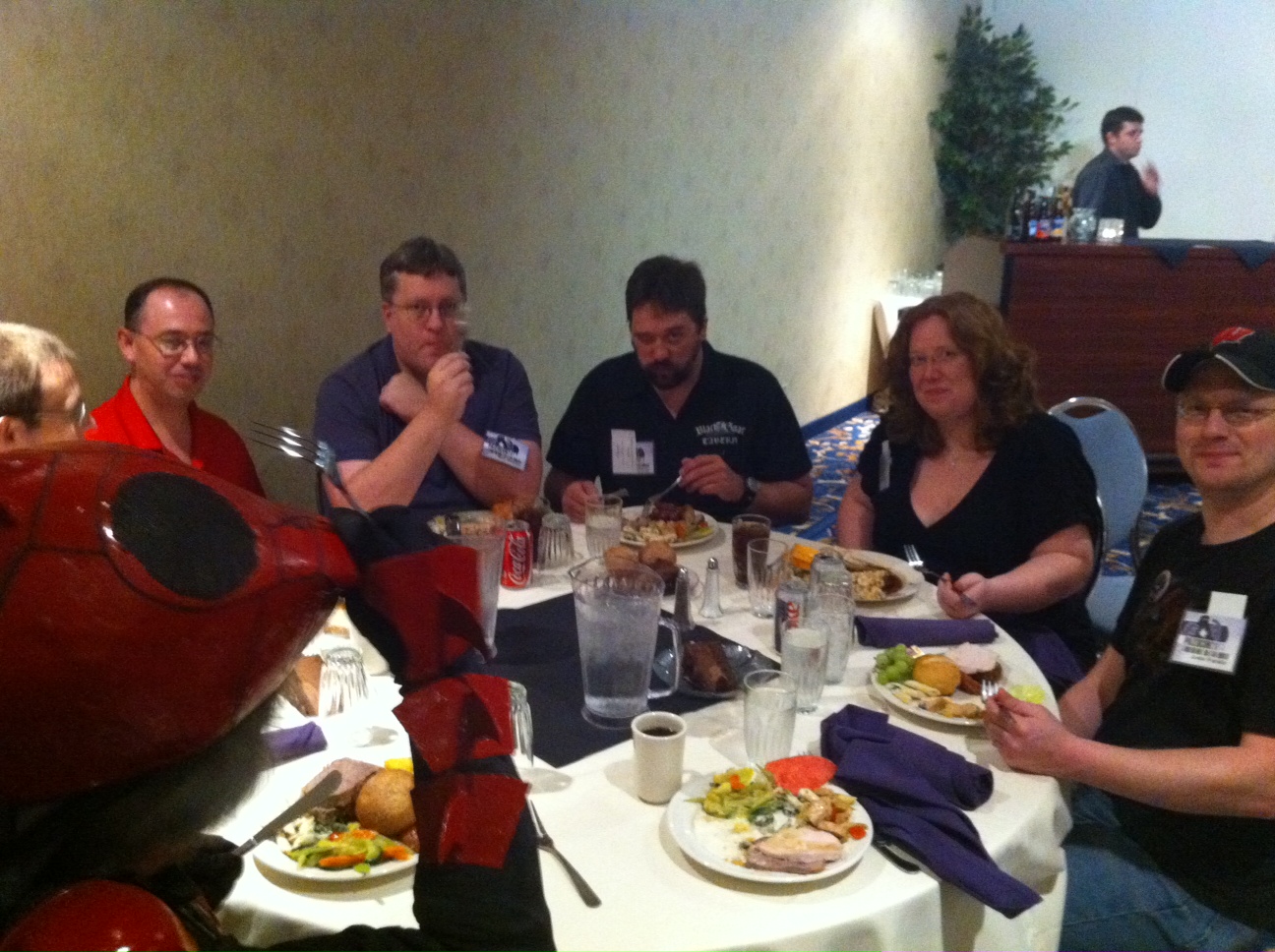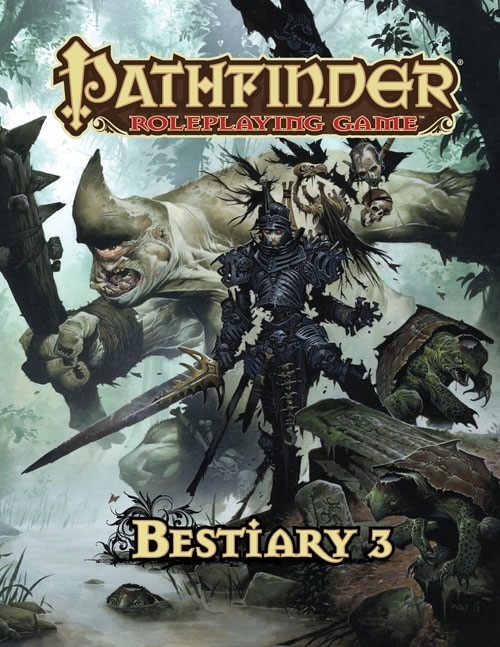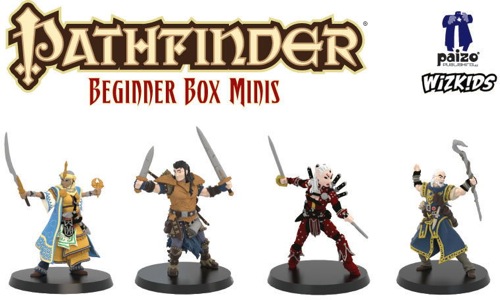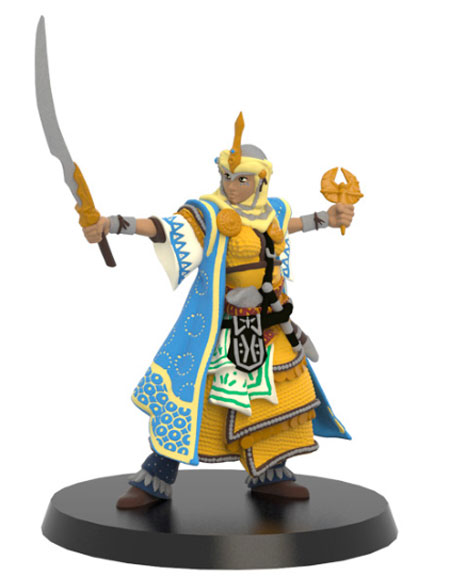For this post, I am pleased to unveil one of my Most Valuable Moles from PaizoCon 2011: Paris "Scoops" Crenshaw, who has gone to the trouble of putting his rough notes into a wonderfully detailed account of this year's announcements for the readers of the blog. Paris, please accept my thanks for your hard work during and after the convention!
From June 9th through June 12th, 2011, Bellevue, Washington played host to a diverse group of gamers, writers, artists and industry professionals, all gathered at the Coast Hotel for PaizoCon 2011. PaizoCon is an opportunity for fans and colleagues of Paizo Publishing, LLC, to get together to socialize, play games, share stories, and learn the secrets about the Pathfinder Roleplaying Game.
But you probably already knew that.
You probably also knew that in addition to the scheduled gaming events, including Pathfinder Society Organized Play, the con schedule is filled with seminars on such topics as small press publishing, having your art or writing published by Paizo and third party publishers, designing RPGs, and drawing maps. Designers, developers, and writers also took the time to share their experiences and give up secrets about the Pathfinder Campaign Setting and future Paizo releases.
The major event that takes place at PaizoCon is the Preview Banquet, wherein the Paizo staff shares a meal, a trivia contest, and a whole bunch of information with attendees. My plans solidified late this year, so I almost missed out on the banquet, but thanks to Charlie Bell from the Paizo messageboards, I was able to get a ticket at the last minute.
So, in gratitude for my opportunity to share the evening with some good friends, and learn some very interesting things about the coming year for Pathfinder, I think it right and good to share some of those insights with you.
Let’s begin with a discussion of Pathfinder RPG product schedule for the next several months.
In August 2011, we will see the release of the much-anticipated Ultimate Combat. This book has been heavily play-tested and hotly debated on the messageboards. I’ll be discussing its contents in greater detail below.
In the Fall of 2011, we will see the Pathfinder RPG Beginner Box, which I will also discuss with more specifics below.
After the Beginner Box, Paizo will release Bestiary III in Winter 2012. This product will include several favorite monsters from products like earlier Adventure Paths and the Bonus Bestiary, as well as new monsters to challenge your players.
The next product discussed is a book called Ultimate Races, slated for Spring of 2012. Since the banquet, much discussion has been held about the appropriateness of the name, leading to the decision to name it the Advanced Race Guide.
The 256-page book will provide tons of information on the seven core races with which players are already familiar. While giving you racial options and archetypes that give more flavor to your favorite PC race, the book doesn’t limit itself to the core rulebook races.
There will also be information on 12 "spotlight races" which are the more common and popular non-core races that players choose for their PCs. There will be information for players of aasimar, tieflings, dhampyr, kobolds, and goblins, as well as the elemental races.
Perhaps even more exciting was the news that the book will introduce PC-playable information on every creature in the Bestiary that advances by class levels. Paizo has released subsequent information that creatures from all three Bestiaries and The Inner Sea World Guide will be covered.
So you can see that there are plenty of new RPG rules options coming up in the next year. After Erik Mona finished tantalizing us with these details, James Jacobs stepped up to discuss the next adventure paths. First up was the AP that will follow Carrion Crown.
Entitled The Jade Regent, this adventure path will take your characters across the face of Golarion, starting from the now-familiar town of Sandpoint, carrying them over the Crown of the World and into the mysterious lands of Tian Xia. As Golarion's analogue for Asia, Tian Xia has been discussed on the message boards and anticipated by fans for a long time, and this adventure path sounds like an excellent way to bring more of Golarion's secrets into the light.
As a side note, Dave Gross's upcoming novel Master of Devils is set in Tian Xia and features Pathfinder's favorite "odd couple" of Radovan and Count Varian Jeggare. I had the pleasure of sitting in on two sessions in which Mr. Gross read the first 5 chapters of August's Pathfinder Tales novel, Master of Devils. In my conversations with Dave about his book, I learned that he tried to provide examples of three great genres of Chinese action adventure film: the romantic film (think Crouching Tiger, Hidden Dragon); the over the top kung-fu movie with superhuman, "flying monks", etc.; and the Chinese fantasy film with otherworldly spirits and fey-like elements. From what I've heard so far, he managed it very well. There’s even a third character’s voice in this book...but I’m not going to spoil it for you. You’ll just have to wait until you read Chapter 5 of the book.
Mr. Gross also read the first chapter of "The Husk", the novella-length Pathfinder Journal, which details the famous pair's adventures in Minkai and the events leading up to Master of Devils. There will also be a web-fiction feature, which occurs even further back in time before the events of "The Husk." Dave asked everyone who heard this to point out that you don't have to wait for the entire Jade Regent adventure path or for the web fiction to come out before reading the Pathfinder Tales novel in August. You'll be able to enjoy all of these stories without reading them in the order they happen on Golarion.
When you combine the novel, the Pathfinder Journal, and web fiction with the upcoming Dragon Empires Gazeteer and all the support material that is certain to be contained in the adventure paths, you'll have plenty of material to add flavor and crunch to whatever Asian-themed Pathfinder campaign you want to run.
On top of all that, you're going to find the same level of quality in art direction that you would expect from the Pathfinder product lines. James Jacobs announced that, for the Jade Regent adventure path, Wayne Reynolds' work will be returning to Pathfinder covers. He showed us some beautiful images from Pathfinder #49, The Brinewall Legacy.
James didn't reveal anything more about the first volume other than what you can read in the product description on Paizo.com, but he did give some fun hints about Pathfinder #50, Night of Frozen Shadows. This second installment of Jade Regent will take place in the Crown of the World, as the characters prepare to make the journey over the northern trade route into Tian Xia. Mr. Jacobs said that you should think of the adventure path as "Vikings versus Ninjas," which sounds like a heck of a lot of fun.
In addition to the new setting information, Jade Regent is likely to introduce some new formatting elements to the Pathfinder Adventure Paths. James mentioned the inclusion of an index for major recurring NPCs, that will hopefully help the gamemaster stay organized when running the campaign. If such elements are well-received, we can probably expect to see them in future adventure paths.
Which brings me to the next announcement James made: The next adventure path after Jade Regent will be set in the Shackles. James said that the working title had been "Skull & Bones," but the official title was recently announced on the Paizo boards as Skull and Shackles, which I think has a decidedly Pathfinder feel to it.
James also said that this adventure path is an inheritor of Kingmaker's legacy and that you might think of Skull & Shackles as "Pirate-maker." In other words, your characters will be able to make names for themselves as notable pirates, building their reputations and perhaps even a hidden lair somewhere on one of the Shackles' many islands. The adventure path will introduce a mechanic to keep track of your fame or infamy, as well as a "plunder score," which presumably will quantify how much you are able to take from those scurvy dogs too weak to defend their treasures. I'm greatly looking forward to seeing this adventure path, as well as the wealth of support material that third party publishers will undoubtedly publish for it.
So, what else was discussed at the banquet? Well, they did go into a little more detail about two upcoming products...
First up was the discussion of Ultimate Combat. To paraphrase Jason Bulmahn, it's about stabbing people. Which is fun, right? I think so...well, in a roleplaying game context, anyway.
As anyone who's been following the open play-test knows, the book introduces three more base classes: Ninja, Samurai, and Gunslinger. The ninja and samurai, of course, support the upcoming Tian Xia releases. The gunslinger, another hot-button topic in the PFRPG world, will be released as a full base class, rather than as a fighter archetype, as it was originally envisioned.
Speaking of archetypes, the book will provide lots of those. According to Jason, the goal was to provide plenty of options to make the "martial classes" even more cool. While the majority of the book focuses on this, Ultimate Combat will also provide options for making combat-oriented versions of spell-casters. For example, there was the much touted revelation of an art piece to go with the gunslinging wizard. I don't know about you, but that sounds like a fun option to me.
Ultimate Combat will also provide the single, largest collection of feats ever produced in a Pathfinder product. Jason indicated it was likely to be the largest they would ever produce, as well. Clocking in at around 250 feats, the chapter's table of feats alone runs for 8 pages. Aside from introducing many great combat-oriented feats, the book will also introduce a new type of feat: "Style Feats."
Style feats are how the Pathfinder RPG will implement various styles of martial arts. From what I could gather, these feats are likely to have trees associated with them, since most characters will focus in only one style. There will however be options for those who wish to study multiple styles. I'm sure this will be a great way to add the White Crane style to your monk's repertoire of unstoppable moves. Of course, no one will ever be able to defeat my cramping hand style...but we don't need to talk about that now.
Moving past the feats section, Jason revealed that Ultimate Combat will contain an expansion of Ultimate Magic's dueling rules, allowing for cinematic sword duels and the like. Additionally, there will be rules for "performance combat" for when your characters find themselves in the arena and need to get the crowd on their side. As a fan of the Starz series, Spartacus and Spartacus: Gods of the Arena, I couldn't help hearing the cheers of "Gannicus!" in my head when I heard that announcement.
Ultimate Combat will also include new rules for vehicle combat, which apparently will help you adjudicate those moments when your characters’ dirigible is attacked by a great wyrm, if the cool artwork is any indication. (You can't help but love the pulpy, action-filled options that the Pathfinder RPG system provides you!)
The book will also introduce several new optional rules systems that you can incorporate into your game, if you choose. There will be a discussion of how to manage piecemeal armor. Jason's description demonstrated how you no longer have to take the GM's arbitrary decision that your combination of various parts from different armor types grants you a +4 armor bonus to AC. Now, you can do a complex series of calculations and determine that the bonus is, in fact, +5! (This was, of course, said tongue-in-cheek. I'm sure the system will be very useful. Really.)
You will also have the option of treating armor as DR, incorporating mechanics for called shots, bringing in the wounds/vitality point system and similar alternate rules to customize your Pathfinder play experience.
Lastly, came the announcement that Ultimate Combat will include a few spells. Before the groans could reverberate off the banquet halls too many times, Jason clarified that these spells were designed to help make fighters and other combat classes better. I assume that means that we will be seeing a lot of buffing spells that team-oriented casters can prepare to support their meatshields...I mean, their companions.
When the talk of combat was all done, Jason moved on to reveal the innards of the Beginner Box. As a father of 9 year old girls who are already asking me if we can play Pathfinder together, I'm greatly anticipating this release, and the more I see of it the more excited I get.
As the product page on Paizo.com will clearly tell you, the box will contain the following:
64-page Hero’s Handbook, detailing character creation, spells, equipment, and general rules for playing the game
96-page Game Master’s Guide packed with adventures, monsters, magical treasures, and advice on how to narrate the game and control the challenges faced by the heroes
A complete set of 7 high-impact polyhedral dice
More than 80 full-color pawns depicting tons of heroes, monsters, and even a fearsome black dragon
Four pregenerated character sheets to throw you right into the action
Four blank character sheets to record the statistics and deeds of your custom-made hero
A durable, reusable, double-sided Flip-Mat play surface that works with any kind of marker
I'll start with a discussion of the pawns, which are paper stand-ups that come with bases. The total count of pawns will be 87. This will include 28 PCs and 59 monsters. I was able to get some clarification from Vic Wertz on the messageboards, and the PC pawns will include the 4 iconics representing the classes in the box set (fighter, cleric, rogue and wizard), so you'll see Valeros, Kyra, Merisiel, and Ezren. The other 24 PC stand-ups will be representations of every gender, race, and class combination among those possible per the Beginner Box rules.
So let's talk about those rules, starting with the Hero's Handbook. This 64-page book will tell you how to build your character and play the game. It will include a solo adventure that players can run to familiarize themselves with the game, even if they're by themselves.
Players of the Beginner Box will be able to play the four core classes mentioned above and will be able to choose to play either a human, dwarf or elf. They will be presented with a reduced choice of skills and feats, which simplifies game play while still introducing players to the basics of the Pathfinder RPG.
The equipment section introduces one of the high-production value choices that Paizo made when putting together this set. Every piece of equipment, including weapons, has a picture associated with its entry in the Hero's Handbook. New players will know exactly what their chosen weapons look like and will have the stats for their equipment easily referenced next to the picture. I had the opportunity to talk with Lisa Stevens about the Beginner Box on Saturday afternoon and she was very animated about the quantity and quality of the art in this product. From what I saw at the banquet, I can see why.
The Hero's Handbook wraps up with a discussion of the basic rules that cover the exploration your characters will do and then discusses combat. To give you an idea about how streamlined the combat system is, the entire combat chapter is only 8 pages long!
During that conversation with Lisa, she revealed the same story that Jason told at the banquet: Paizo contracted a blind play-test study of the box set, in which a group of 14-year-olds were given the box and simply told to play the game. The developers were able to watch the children through a one-way mirror as they opened the box, read the rules and started playing Pathfinder within about 20 minutes. As I said, I'm a dad who's looking forward to this product.
In addition to the Hero's Handbook, the box holds a GM Guide, which contains a short adventure set in everyone's favorite Varisian coastal town of Sandpoint. The book also has the information GMs need to run the game and create adventures of their own. And there are magic items, both old and new, so even those who already know how to play Pathfinder will find something useful. Lastly, the monsters in the boxed set are presented in a new format, providing a picture and a one-column text entry.
Overall, I predict this is going to be a fantastic product that will have secondary effects on design within Paizo. For a long time, our hobby has been a game that must be taught. The challenge of diving into a massive rulebook and figuring out how to play the game is just too much for most people to undertake without the help of someone who already knows how to play.
The developers had to do a lot of work and "change of thinking" to present a true Pathfinder RPG ruleset that someone completely unfamiliar with the game can pick up and start playing in 20 minutes. My guess is that those lessons won't be forgotten, but will instead be carried forward and applied to the way future RPG products are written.
So, that's my recap of the Pathfinder Preview Banquet from PaizoCon 2011. I attended many other seminars during the weekend and learned a heck of a lot, in addition to spending time with good people from the Paizo and Pathfinder community. I can't wait for my next PaizoCon. Perhaps I'll see you there!
About the Guest Blogger:
Paris Crenshaw is a US Navy officer, currently stationed in San Diego, California. He is a writer and editor of speculative fiction and RPG materials, published in Wayfinder magazine, as well as a member of the Wily Writers group (wilywriters.com) and PathfinderChronicler.net.


































